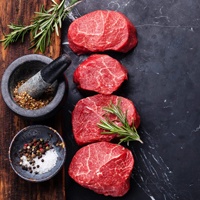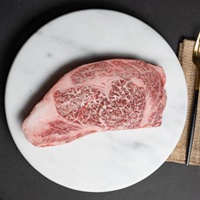Meat The Truth – Beef
MEAT THE TRUTH – BEEF
Why Being Vegan is a Huge Missed Steak

Carnivores tend to be smarter than Herbivores
• Since brain tissue takes 20 times more energy to grow than liver or kidney tissues, meat-eating likely helped humans evolve larger brains.
• Many of the planet’s most intelligent species are carnivorous (dolphins, ravens) or omnivorous (Humans, chimpanzees)

A diet of lower beef doesn’t mean higher health
• When health-conscious meat-eaters are compared with health-conscious vegetarians, neither are found at a higher risk of diseases than the other.
• Human ancestors have been omnivores for 1.5 million years, and we thrive best with a balanced diet of meat and vegetables.
• Many people make the switch to a veggie/vegan diet because of eco-conscious reasons, not health reasons.
But here’s the Good News: You don’t need to sacrifice your favorite filet for a good cause,
you can have a healthy diet and a healthy planet.
Raising the Steak

With great hunger comes great responsibility.
• Sustainability: Buy steaks from farmers who practice caring for the planet as much as caring for their cattle, and together you can reduce our carbon footprint. Sustainable farming can include things like:
• Avoiding chemical pesticides
• Crop rotation
• Caring for local streams and water reservoirs
![]()
HUMANITY:
Humanely-raised cattle live lives of lower stress, happier days, and higher health than factory-farmed animals.
Healthier cows lead to healthier meats, and healthier meats lead to healthier meals.
![]()
GRASS-FED:
Grass-fed beef comes from cows who were allowed to forage out on a pasture, allow-ing them to carry out more of their natural habits.
Beef from grass-fed cattle are highly unlikely to have traces of E. coli bacteria.
Cows who were raised on pasture have 60% less stress than commercially farmed cat-tle.
![]()
NO ANTIBIOTICS:
Many factory-raised animals are given antibiotics to promote faster growth, but eating too much of these meats can cause humans to become more vulnerable to antibiotic-resistant bacteria.
80% of the antibiotics produced in the U.S. are administered to farm ani-mals.
Look for steaks that are labeled “No Antibiotics Added”.
![]()
NO HORMONES:
Hormones are often used to speed up the growth of farm animals as well.
While there is few evidence that this can harm humans who eat the meat, hormones cause several health issues to the animals they are given to.
Look for steaks that are labeled “No Hormones Added”.
Chop Shopping

You are what you eat, look for the sweet spot
where freshness meats quality.
MARBLING
A steak’s marbling is the specks and swirls of white fatty tissue found throughout the meat.
Higher marbling leads to delicious flavor and extra juiciness.
COLOR
A brighter red color usually indicated a fresh cut of meat, but remember:
 Some low-quality supermarkets dye their meat to make it
Some low-quality supermarkets dye their meat to make it
look fresher
 Bright red meats are not as tender as those that have
Bright red meats are not as tender as those that have
had some time to soften
 A brownish color does not mean the steak is rotten, it may have just been aged for tenderness and flavor
A brownish color does not mean the steak is rotten, it may have just been aged for tenderness and flavor
 Many meat-lovers prefer the rich and buttery “melt-in-your-mouth” flavor and texture of dry-aged beef. To enjoy the most tender, flavorful meat possible, make sure it’s the freshest meat possible.
Many meat-lovers prefer the rich and buttery “melt-in-your-mouth” flavor and texture of dry-aged beef. To enjoy the most tender, flavorful meat possible, make sure it’s the freshest meat possible.
 Buy locally and support sustainable family farms
Buy locally and support sustainable family farms
 Find never-frozen protein products
Find never-frozen protein products
 Take advantage of speedy meat delivery services
Take advantage of speedy meat delivery services



















